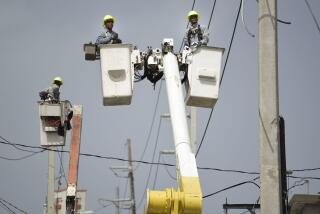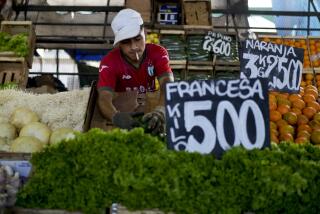Peru Hopes New Austerity Can Slow Raging Inflation
- Share via
LIMA, Peru — Peruvians tightened their belts Wednesday after the government announced new austerity measures that more than doubled basic food and gasoline prices and devalued the national currency by 50%.
The moves come as part of Lima’s effort to battle the country’s hyperinflation and massive budget deficit, but they are likely to set off a storm of protest from consumers, who lined up for hours Wednesday to buy goods in scarce supply.
Peru will shift its exchange rate from 250 Peruvian intis to the dollar to 500 intis, while prices will rise from 40% to 270% for goods such as bread, milk, chicken and rice, Economy & Finance Minister Abel Salinas Eyzaguirre said in a televised address Tuesday night.
Living Standards Plunge
Gasoline prices will rise 225%, he added, while the minimum wage will increase 60% to $48 a month.
While Salinas said he hoped the measures would wipe out Lima’s massive budget deficit in six months, economists say they doubt he will succeed and that the measures will cause consumers great hardship.
“Many housewives won’t be able to feed their families this week,” said one private economist.
“It’s the poor who will suffer most,” added a Western diplomat.
The package is designed to combat Peru’s economic crisis, in which living standards have plunged because of soaring prices. Salinas said government subsidies of food prices are behind much of the inflation, which ran at 1,100% in the year to October.
While economists said they feared that higher prices and wages could push annual inflation to December up to 2,000%, Salinas said he was confident about the plan.
“We all know that we are living in crisis, but we all know that we should overcome it with concerted effort,” Salinas said, although he did not specify when the measures would take effect.
Every day Peruvians line up for hours, sometimes from 4 a.m., to buy basic foodstuffs. Sugar, milk and bread are scarce as Lima lacks the foreign reserves to pay for imported goods.
While Peru’s minimum wage will increase, homemakers complained bitterly that the greater price hikes have slashed the purchasing power of their modest incomes.
“The money is not enough,” said Eloisa Ramos, a retired teacher. “We buy less and we eat less.”
The austerity also could provoke unrest in the countryside. A wave of strikes arose in September when President Alan Garcia doubled food prices and cut the exchange value of the inti in half.
No Exchange Reserves
Diplomats and economists did not rule out the possibility of rioting and looting as occurred in September. Meanwhile, rumors persist that Garcia will resign or be ousted in a military coup.
But goods may return to Peru’s stores, economists and diplomats said, if speculators stop hoarding now that the uncertainty over the price hikes has ended. In addition, the inflation rate could start falling early next year if Lima can cut its budget deficit, they added.
The country still lacks foreign exchange reserves, as the output of its major currency earners--copper, silver and gold--has been frozen since Oct. 17 because of a mining strike.
Peru has lost $700 million in export earnings from the strike, Energy and Mines Minister Jose Carrasco Tavara was quoted as saying by the state news agency Andina. Peru’s foreign cash reserves have dwindled to $50 million, according to central bank officials.
More to Read
Sign up for Essential California
The most important California stories and recommendations in your inbox every morning.
You may occasionally receive promotional content from the Los Angeles Times.













